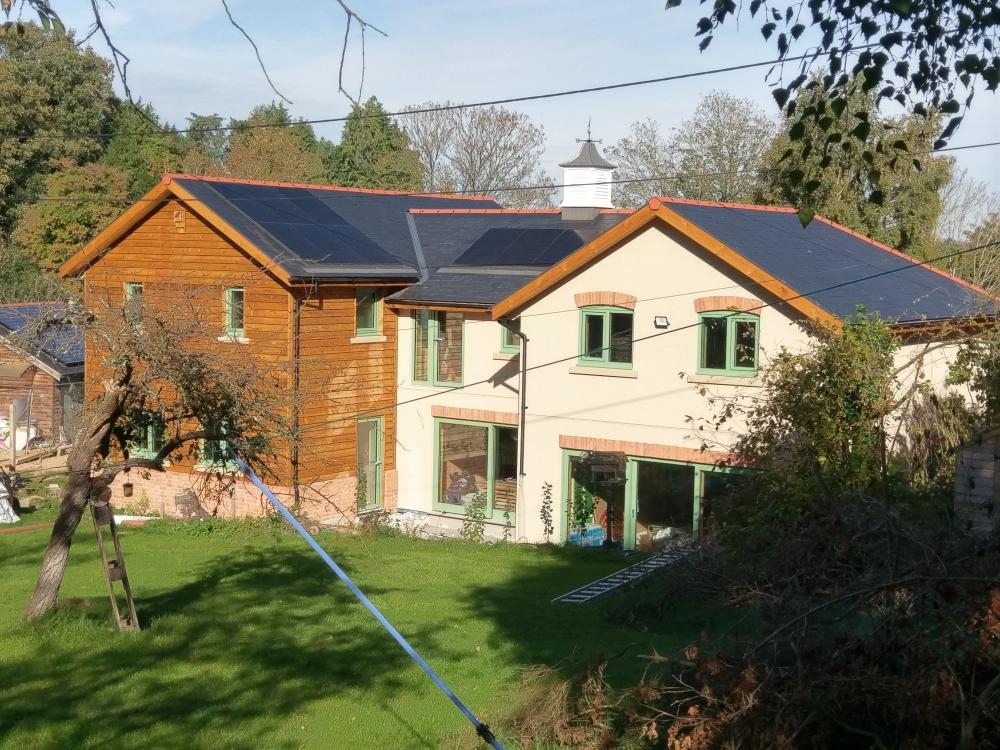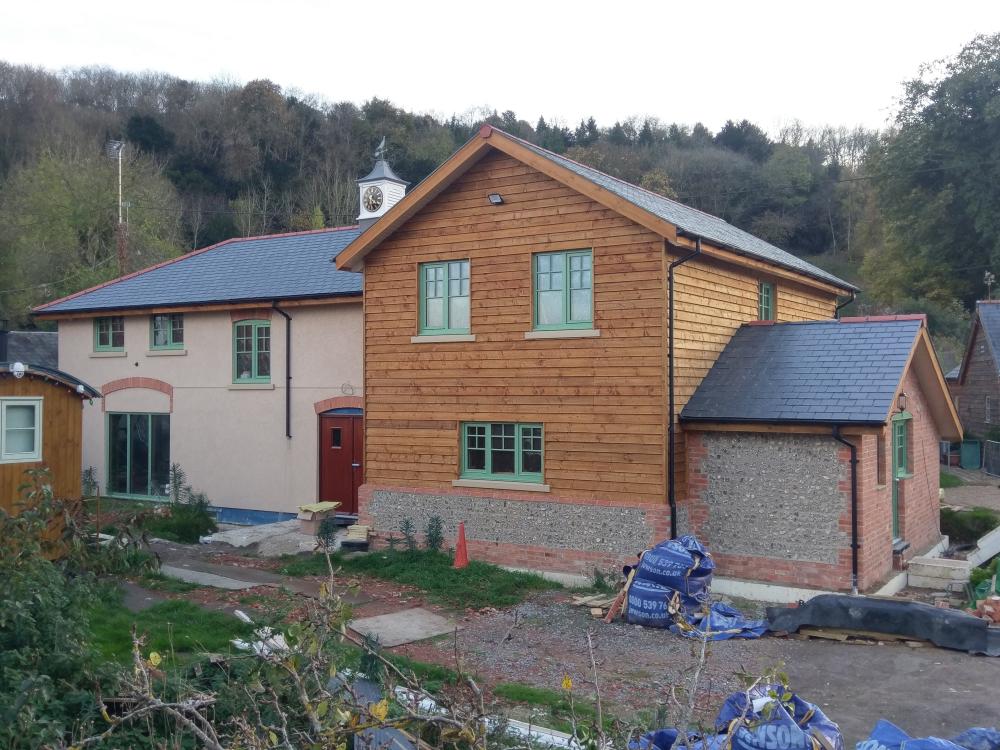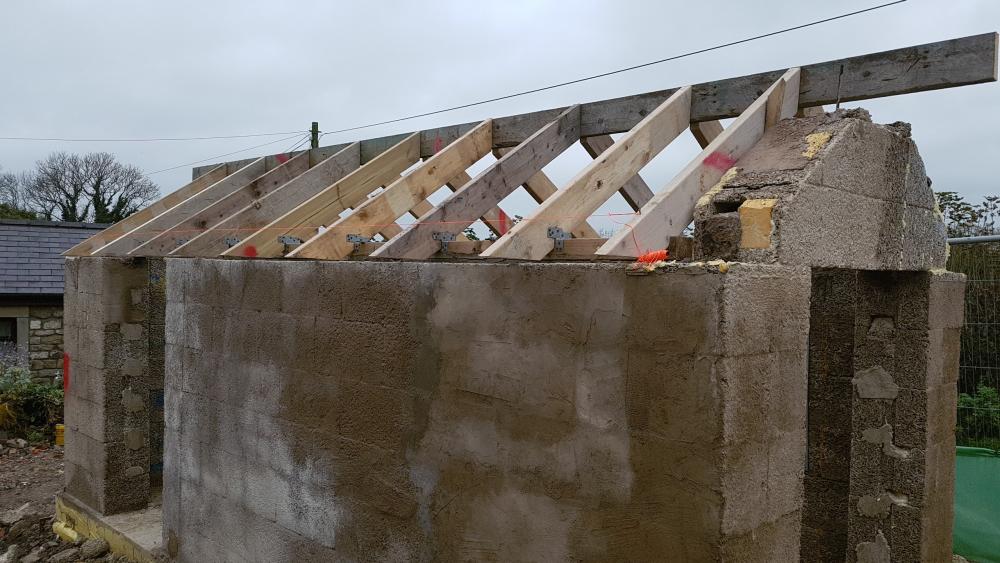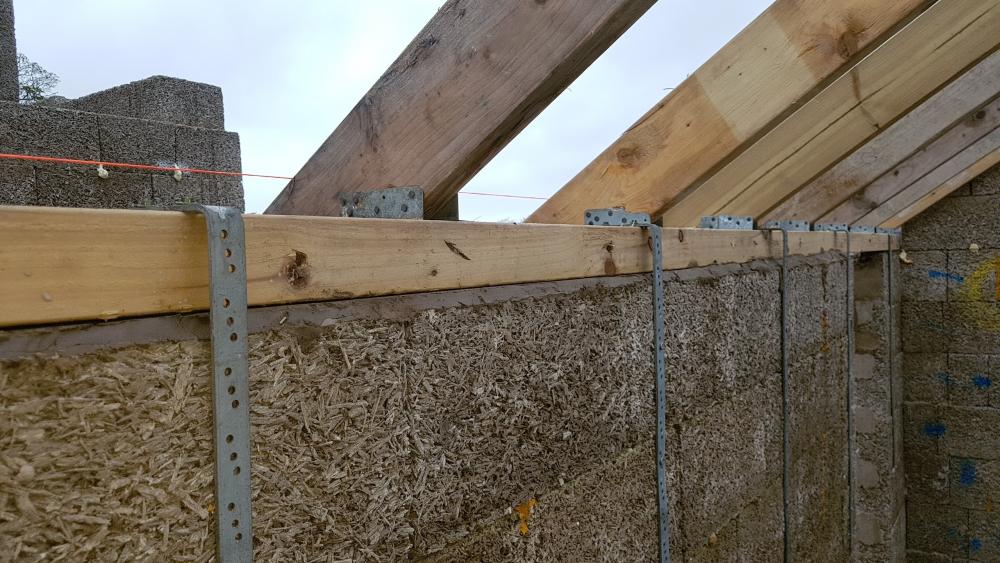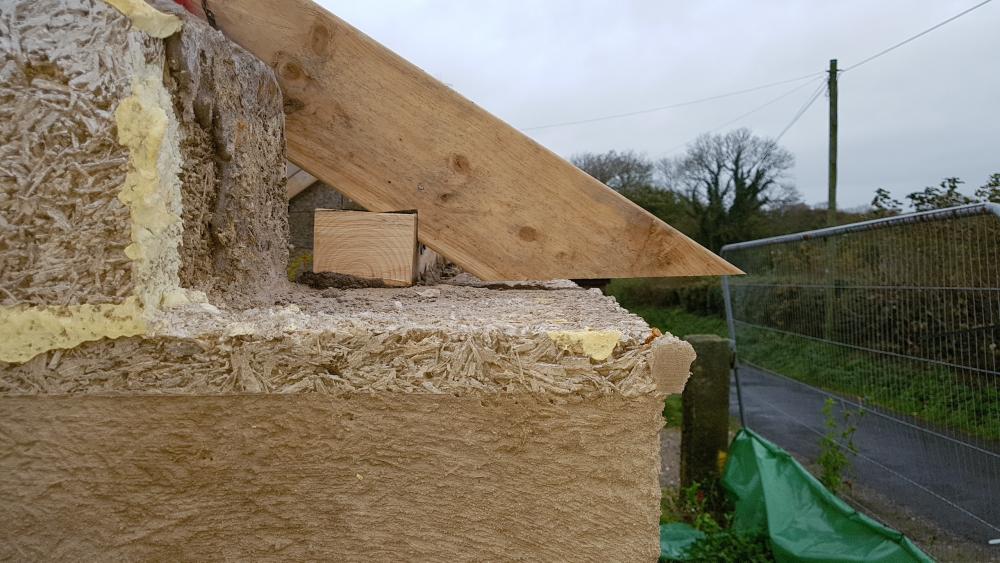Leaderboard
Popular Content
Showing content with the highest reputation on 10/31/17 in all areas
-
Few pics ( hopefully they work), used Lugo 400x200mm slates, 100mm lap and batten spacing, with slate hooks and copper nails for edge slates.2 points
-
I converted a church which finished about 3 years ago for a client. Planning took about a year, detailed design about 5 months and construction was about 10 months. It was a big job (over 2 million) as it was a big stone church and over 100 years old but I’m sure some of the same principles will apply. You’ll need a good architect and possibly a conservation architect. These points are in no order and just as they come to me: Meet the local priest We met with two of the local priests during the design stage. The church was closed about 6 years but still had some religious items stored in it. It was critical to get an inventory of these done up and see exactly what the church wanted to keep. eg some timber pews, old damaged organ (dump), statues, altar, etc. It was also important to get their ‘blessing’ as we didn’t want any objections from locals who could claim we destroyed their former place of worship. The planners should also want this recorded and a photographic record of the building submitted with planning so it can be kept on file. Meet the planners We met the planners, local authority conservation architect, heritage, etc several times before lodging our planning application. They were reluctant on some of the more modern interventions so planning and design took a while. We also had trouble with fire (a huge exposed timber roof, timber wall paneling, original doors we were retaining which we'd restore but which wouldn't be certified as fire doors, etc). We just had to sit down and work through the items with them. Opening up/investigation works On a building this old you’ll never know what you’ll find. Get a local builder in for a few days to carry opening up works in about 10 places, floor, walls, roof, etc. You’ll get to see the build up, condition, etc. eg what state the roof timber is and what’s the build up. We found lovely original red brick and glazed tiles which were hidden behind some modern chipboard installed in the 60’s. This allowed us to include drawings and restoration specification into the tender package for builders. Another item we did during the upening up works was a drilling core test to check the load bearing capactiy of the existing floor. We knew we wanted a mezenine or second floor but wanted to know if the existing floor could support it (it couldn’t). Knowing the bearing conditions meant we knew before going to tender how much of the existing floor would have to be removed and how deep we’d have to dig. Light & Ventilation A key problem for us was getting light and ventilation into the church as it had original stained glass windows we couldn’t touch and didn’t want to go knocking giant holes and MVHR grills into the walls. We carried underground ducts under the floor and outside about 4-5 meters from the church where they took in fresh air hidden in a sloped bank. We then used rooflights on the non visible side of the church which was by chance south to let natural light in. Services We were close to electricity, mains water, gas, fiber internet, etc. but did have to coordinate these. As it was a protected building we got permission to build a concrete pillar a few meters from the church (close to where the ventilation ducts terminated around the back) where we installed the electricity and gas meter. We didn't want an electricity or gas meter fixed to the side of the church. This coordination did take a while and almost delayed the project. Bats & Birds Old churches are well known for having bats and birds resting in their eaves. We had some really rare bird which only nests in historic buildings. Ensure you've done a bat survey prior to tender and try and cordinate roof works outside the mating season or whatever season you're not allowed. We ended up having to phase the roof to ensure it was finished in time to allow the birds build their nests again in early spring and then had to move hoarding as it obstructed the flight path. Some things you have to do to please the local conservation and heritage officer. I've loads of other info but this post is already getting long. The project ended up winning an architecture award so if you want more info I can PM you.2 points
-
2 points
-
In this entry I'm going to discuss in more detail how I came to choose our heating and hot water system, and how it has performed to date. As other forum members have found, deciding which fuel source and type of technology to use in a low energy house, is a challenge given the different requirements each of us has. We had three stipulations – low running costs, hot water available on tap 24/7 and maintenance of the whole house at an even and constant temperature 24/7. Having calculated our heating demand, taking the impact of solar gain, incidental household gain, human occupancy and wind speed into account, I was confident that I had a good indication of the amount of heating I would need. I was also confident, based on historical use, of the amount of hot water we as a family use. Living in an area without mains gas, my options were somewhat limited to using either oil or electricity as my fuel source. LPG was initially considered but discounted due to the lack of availability in my location. As part of the decision making process, I spent a fair amount of time carrying out a cost comparison of both oil and electricity based heating and hot water systems, using 500kWh increments from 2500kWh to 5000kWh. I considered direct electric of various type, oil and air source heat pumps, both air to water and air to air. Solar PV was also considered and costed in terms of each method of heat and hot water delivery. In line with previous cost comparisons that I had carried out, I found direct electric to be the most cost effective in terms of capital outlay and running costs when both heating and hot water demand were less than 2500 kilowatt hours each year. As heating requirement and hot water requirement increases so the balance began to tip in favour of other technologies. Oil was quickly dropped from the list as it became apparent that any rise in fuel prices over then then low point, would significantly increase running costs. Having conducted significant investigation in respect of the viability of Sunamp units, although attractive in many ways, I found that the capital outlay and running cost was simply too high to be able to justify, given that the main benefit (low heat losses) were not as critical for me as they have been for others. Part of that decision was also driven by the cost of fitting Solar PV, which in our remote location was extortionate. I looked into a non MCS DIY install, but couldn’t make the figures stack up, the break-even point being around 17 years. Much as I wanted to install PV, it didn't make any sense financially. In time, I hope to revisit PV, if and when battery storage reduces the break-even point to a more realistic timescale. A wind turbine, given our location and the virtually constant presence of wind, would have been an ideal energy source and paired with Sunamp technology, probably unbeatable. The proximity of nearby houses ruled out that option in terms of planning permission. Air to Air heat pumps were ruled out based on my own experience of them and a road test at a friends house. Neither myself or my good lady found them particularly pleasant as a heat source. Having gone through the list of options, an air to water air source heat pump, paired with a large UVC and UFH for the distribution of heat, represented the best balance in terms of capital outlay, running costs and crucially, comfort and convenience. We opted for a package from Mitsubishi Ecodan, an 8.5kW heat pump and 300 litre pre-plumbed cylinder fitted with the Mitsubishi FTC5 control panel. Given our location, we opted for the coastal model, which is treated with acrylic resin for enhanced corrosion resistance. Whilst a pre-plumbed cylinder is more expensive than a bare cylinder and associated parts, after taking labour (plumber and electrician) into account, I found there was very little difference in cost. I sourced the package from a trade supplier, Secon Solar. I found their price list while searching online and having phoned the company, and perhaps fortuitously speaking to the managing director of the firm, found they were quite happy to sell me package at trade / installer price, the bonus being that delivery to my location was free. The package is configured for the UK market, the only difference to the system as sold in the rest of Europe (AFAIK) being that the cooling function of the heat pump is disabled so that the product complies with MCS approval for claiming RHI. It is however a simple task to activate the cooling function, by flipping a dip switch in the control module on the cylinder. Cooling can then be controlled from the master controller. As stated in an earlier blog entry, the heat pump and cylinder were fitted very quickly with simple connections on the plumbing side – flow and return from the ASHP, cold water, hot water and flow and return to the underfloor heating manifold. Electrical connections consisted of power to the ASHP, a cable from the ASHP to the control module and a plug-in controller. I had initially planned to have the cylinder in the utility room close to the ASHP Monobloc, but changed the location to a service cupboard in the middle of the house, to reduce internal DHW pipe runs. This does mean a 15 metre pipe run for flow and return to the ASHP, but as virtually all is within the insulated envelope, it doesn’t represent much of an issue, and does not appear to be having an adverse effect on performance. The ASHP Monobloc itself is located beside our back door, open to the elements. It seems happy enough where it is, despite the wind that traverses the space between house and garage walls. Locating the ASHP within the garage itself was an option but one I decided against simply on the grounds that I didn’t want to give up floor space within the garage. A timber housing for the ASHP is something we may look at in the future. We opted to fit individual room thermostats to all 3 bedrooms, to give us the option of being able to reduce the bedroom temperatures if we so wished. We have not used these and keep the whole house at one temperature 24/7, treating the underfloor heating as a single zone. At present I only have limited data as to how the heat pump has performed since moving in. On board energy metering (energy consumed and energy produced) shows the CoP for heating has ranged between 3.5 and 4. DHW is maintained at 47C-50C in the cylinder, boosted every fortnight to 60 degrees by the immersion on an anti-legionella cycle. To date the CoP for DHW is 2.4 As members know, heat pumps are best suited to the production of low temperature heat as opposed to the higher temperatures required for domestic hot water. Whilst the CoP for DHW is lower than that for heating, the cost per kWh of our DHW, based on a CoP of 2.4, is 5p, which is significantly better than an E7 electricity tariff. We may be taking a hit on efficiency, but in reality all of the other options would have cost us more. The 300 litre capacity of the cylinder means that we have plenty of hot water on tap and can comfortably run a full bath and still have sufficient left over for another person to shower. The ASHP is currently operating on a 24/7 basis, providing heat input to the UFH and topping off the DHW as and when it determines it needs to, at whatever flow temperature it determines. Whilst that does sound like a recipe for high bills and high flow temperatures, in practice, the heat pump delivers the lowest flow temp it can get away with to maintain our set temperature. If I so choose, the controller lets me set various parameters such as heating curves or set flow temperatures, or indeed a timed schedule for heating and DHW. However,as the system is operating efficiently on its auto setting, and providing the level of comfort we want, I see very little reason to mess around and create my own settings. If say electricity tariffs were to change from a single tariff to a dynamic tariff, then I would have the option of timing the heat pump operation to coincide with lower rate tariffs. After much thought, and indeed discussion on this forum, I opted for an 8.5 kWh ASHP over a 5 kWh ASHP, as I felt happier running a larger unit more gently than pushing a smaller capacity unit harder. A 5 kWh unit would probably have sufficed, and in time, may be what the current unit is replaced with when it reaches the end of its life. We haven’t yet had to activate the cooling function as any overheating (defined as internal temperatures over 23C) caused by solar gain, can, as modeled, be managed by natural cross ventilation. Neither have we found it necessary to constantly circulate the UFH to even out the house temperature / redistribute solar gain from one part of the house to the other. In the heating season, we found that there was sufficient circulation of the UFH during the heating cycle to maintain the house at an even temperature. Outwith the heating season, when solar gain is at its peak, the house zones itself, the bedroom section remaining slightly cooler than the public areas, very useful on a warm summers day. Overall I’m very happy and impressed with our system. It has, so far, delivered everything we have asked of it in terms of comfort and convenience, and the running costs are low. I have the capability to cool the house (via slab cooling) if I so wish, and the option to bolt on a second zone pack onto the pre-plumb cylinder if I ever found it necessary to install a second heating / cooling function – i.e. fan coil or duct heater / cooler. The one criticism that I have is about the controller thermostat function and its hysteresis - 1C increments only. A finer degree of control would have been preferable. Our installation was recently inspected by an MCS accreditor (our plumber is going through the accreditation process). In due course that will give us the option to apply for RHI, although that will be very much dependant on whether the figures stack up.1 point
-
Unfortunately Salus are keeping things really close to their chest, with very little technical detail about how these work, or even what sort of hysteresis the temperature setting had. From a very brief play around it seems that the drive mechanism is a geared motor that drives both a threaded rod that drives the actuator pin, and winds up a spring to allow the power off close. The two clip on sensors seem to be thermistors, I think, and it doesn't matter which is the hot one and which is the cold one, the system just maintains a nominal 7 deg C between the two, if it can. In my case it seemed to be maintaining about 6 deg C very well, so there could be a bit of a tolerance. The case does look like it will unclip, so I'm tempted to order a spare and take it apart, to see if it can be reverse engineered. The information from Salus is so poor that it doesn't even tell you that there is an LED that shines through the case and which stays on when the valve is actively motoring, or flashes when it is adjusting the temperature. The latter process is does in stages. It seems that the valve moves the pin a bit, waits for a minute of two to see what has happened, then moves the pin a bit more, until after a few minutes it has set the pin at the right place to maintain the set temperature differential. The ability to set this differential on the outside of the unit, using a small adjustment pot, would make this unit very versatile indeed. As it stands, used as I'm using it, as an entire manifold temperature control regulator, it is pretty close to perfect for our house. I could use maybe 1 deg C lower in the temperature differential, to get rid of a bit of the residual overshoot, but there may be ways I can do that by repositioning the sensors. Right now I have them just clipped to the nearest flow and return pipes, but they are long enough that I could strap one to the ASHP flow pipe, where it would see a slightly higher temperature. It would need a new clip, as the supplied clips are designed for 16mm pipe, but the sensor just slides out of the clip and could, I'm sure, be made to fit a standard pipe clip. It would be nice if Salus released more information on these units, as they seem to be potentially far more useful than the limited information about them might suggest.1 point
-
This has got to be the best/most helpful forum I've ever been on. (And I am registered on tonnes of car forums!) The self-build mortgage broker has agreed our funding in principle (affordability looks well within limits, basically) and i'm awaiting a response from the water board to see if it has waste/foul water set up, or if not, where the nearest point is we'd have to connect to. I'm going to have to speak with local builders (or get recommendations of) to give me an idea of the full budget required. Thanks for all the help so far. (Dudda - thanks for taking the time to put all that together).1 point
-
Not really as long as you're sensible. It's a good idea to fix a label onto the outside of the bag saying it's possible asbestos. Edit: Link to the CAR regs http://www.hse.gov.uk/asbestos/regulations.htm1 point
-
I've been doing our internal doors, you can do one with a brush in 20mins or so with a brush, just go lightly on the cover so it doesn't run everywhere. It'll take longer to mask them up and spray them1 point
-
I've just done a small roof on an outbuilding. Turned out well, used these links - https://www.fixmyroof.co.uk/videos-and-guides/pitched-roof/slate-a-roof/ and http://source4me.co.uk/calculate_roofing_slate.php plus im sure a few YT vids.1 point
-
I made this bit of roof out of bits of timber that were lying around on site - the ridge was in an old shed we had to knock down to make way for the house...so it's at least 30 years old. Wall straps put in yesterday Pleased I thought to make a space for a soffit so that I can disguise the banana shaped front wall So, it's a few hours on YT -again- so I can work out the batten positions. I think I have enough spare discarded 4 by 2 to cut up and make my own battens. Anyone got a link to decent online roofing (as in DIY your own roof)? Ian1 point
-
We used ESP for our MBC TF build, I agree that they did try and push us to the larger size ASHP for our house but after talking to them over the course of a few months they realised it wouldn’t be required. We have a Varimax ASHP, Ecocent for DHW and their MVHR, all installed and designed by them and can’t fault any of it. They have been great from beginning to end, and unless things have changed would have no issues recommending them for anyone to use. In hindsight we probably should have installed a fan coil raditaor or something upstairs we have one very large master bedroom upstairs with 4 large velux’s and a 3 meter high glazed gable and it can get a bit cooler in the depths of winter, but 5 minutes with a 1.5kw fan heater it is fine. Although we only got round to putting up the curtains in the summer and I expect that will have a big impact as it’s not cold in the morning when you have slept in there. We applied for RHI after the ESP install we currently get around £400 a year and our heating bills all electric for a 300 m2 house is around £900 a year. We have no solar either.1 point
-
It was a complicated 3 year process including an appeal. I'll DM you. Suffice to say that although I have 30 years experience as an architect I wouldn't have managed to get PP without Berwyn's expertise. His fees were very reasonable too.1 point
-
Western Red Cedar can be pruned into a really nice cone or pinnacle but needs doing annually - the trick is to take the tip leaders out as it will develop 5 or 6 main branches that will form the cone. RHS is always a good source of guidance. Here Easier if there are two of you - one standing back and giving direction, and Mrs JSH up the ladder with the secateurs ....1 point
-
Now that you are going to be living here, we and @RandAbuild are pretty much within spitting distance1 point
-
TBH I agree with you. In that model the new one looks very dominant. It would be a surprise to me if It helps in that form. However your Planning Consultant is the local expert and their opinion is far more weighty than mine. I think if presented with that as a Councillor on Planning Committee or as a potential local objector, I would be concerned enough to ask some awkward questions. I think you need to communicate that the house is in a far larger context than that shown on this model, so the extra space is really a very very minor overall change. One way to do that might be to have a small scale model of the landscape showing how small it is in the context of your 19 acres and umpteen lakes, then a model showing the detailed house and no landscape, demonstrating the high quality of the design - so the change is de-emphasised and the old size vs new size is not discussed in the same breath. I might be tempted to get the latter one 3D printed and dismantleable by layer. If you have to have one of house plus some landscape, then I would suggest putting enough landscape in to place it properly in context, and I would turn eg all that brown into green. If the lake moves then I would perhaps model it with the water lower eg in high summer. Never show the two side by side in the form imo. If you make sure to call it an "'illustrative" model In the definitive places even if you call it just a "model" elsewhere, then you cannot be formally bound by it. I would use it as a prop to your presentations rather than something you let people take away. Ferdinand1 point
-
@JSHarris Wunda just supplied me with a new manifold for a customer to replace the mess that some goon fitted. They recommended the Salus auto balancing actuators which open with stepper motors, a lot quicker than the wax heated ones. Literally open to closed in a few seconds. Manufacturers patter Wundas patter and cost These have a pair of capillary wires, one for flow and one for return, to sense temp differentials and balance accordingly. Under max flow I'd say the longest I waited for fully open / closed was around 30 seconds as they struggled a bit against full pump force on one circuit open. Much quicker when the pump potential was divided.1 point
-
@PeterW It's required practice to seal the panels with a special paint so it prevents fibers from dislodged if it is Raw asbestos ... I spoke with our compliance officer at work (NHS) and he confirmed that it's the correct protocol. Belt and braces!!!1 point


